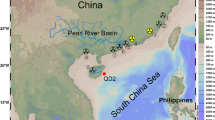Abstract
The dose rates for six marine organisms, pelagic fish, benthic fish, mollusks, crustaceans, macroalgae, and polychaete worms, representative in marine ecosystems, have been predicted by the equilibrium model with the measured seawater activity concentrations at three locations around the Fukushima Daiich nuclear power plant after the accident on March 11, 2011. Model prediction showed that total dose rates for the biota in the costal sea reached 4.8E4 μGy/d for pelagic fish, 3.6E6 μGy/d for crustaceans, 3.8E6 μGy/d for benthic fish, 5.2E6 μGy/d for macroalgae, 6.6E6 μGy/d for mollusks, and 8.0E6 μGy/d for polychaete worms. The predicted total dose rates remained above the UNSCEAR’s (United Nations Scientific Committee on the Effect of Atomic Radiation) benchmark level (1.0E4 μGy/d for an individual aquatic organism), for only the initial short period, which seems to be insufficiently long to bring about any detrimental effect on the marine biota at the population level. Furthermore, the total dose rates for benthic fish and crustaceans approximated using the measured activity concentration of the biota and bottom sediment was well below the benchmark level. From these results, it may be concluded that the impact of the ionizing radiation on the marine biota around the Fukushima NPP as a consequence of the accident would be insignificant.


Similar content being viewed by others
References
Bailly du Bois, P., Laguionie, P., Boust, D., Korsakissok, I., Didiet, D., & Fievet, B. (2011). Estimation of marine source term following Fukushima Daiichi accident. Journal of Environmental Radioactivity, 45, 15077–15078.
Buesseler, K.O., Jayne, S.R., Fisher, N.S., Rypina, I.I., Baumann, H., Baumann, Z., Breler, C.F., Douglass, E.M., George, J., Macdonald, A.M., Miyamoto, H., Nishikawa, J., Pike, S.M., Yoshida, S., (2012). Fukushima-derived radionuclides in the ocean and biota off Japan, PNAS early edition, www.pnas.org/cgi/doi/10.1073/pnas.1120794109.
Garnier-Laplace, J., Beaugelin-Seiller, K., & Hinton, T. G. (2011). Fukushima wildlife dose reconstruction signals ecological consequences. Environmental Science and Technology, 45, 5077–5078.
Howard, B. J., Beresford, N. A., Copplestone, D., Telleria, D., Proehl, G., Fesenko, S., et al. (2012). The IAEA handbook on radionuclide transfer to wildlife. Journal of Environmental Radioactivity. doi:10.1016/j.jenrad.2012.01.027.
IAEA, (2004). Sediment distribution coefficients and concentration factors for biota in the marine environment, Technical Report Series, No.422, IAEA, Vienna.
Keum, D.K., Jun, I., Lim, K.M., Choi, Y.H., (2010). K-BIOTA V2.0 user’s manual, Korea Atomic Energy Research Institute, KAERI/TR-4230/2010, December(Korean).
Keum, D. K., Jun, I., Lim, K. M., & Choi, Y. H. (2011). Approach to non-human species radiation dose assessment in the Republic of Korea. Radiation Protection Dosimetry, 146, 299–302.
Keum, D. K., Jun, I., Lim, K. M., & Choi, Y. H. (2013). Radiation dose to human and non-human biota in the Republic of Korea resulting from the Fukushima nuclear accident. Nuclear Engineering and Technology, 45, 1–12.
Kryshev, I. I., Kryshev, A. I., & Sazykina, T. G. (2012). Dynamics of radiation exposure to marine biota in the area of the Fukushima NPP in March-May 2011. Journal of Environmental Radioactivity, 114, 157–161.
Larsson, C. (2008). An overview of the ERICA integrated approach to the assessment and management of environmental risks from ionizing contaminants. Journal of Environmental Radioactivity, 99, 1364–1970.
MEXT, (2011). Readings of sea area monitoring at post out of Fukushjma Daiichi NPP, News release, Internet www.mext.go.jp/english/incident/
TEPCO, Tokyo Electric Power Company. (2011). Detection of radioactive materials from seawater near Fukushima Daiichi nuclear power station. with attachments. Press release. Internet www.tepci.co.jp/en/press/corp-com/release/
Ulanovsky, A., & Proehl, G. (2006). A practical method for assessment of dose conversion coefficients for aquatic biota. Radiation and Environmental Biophysics, 45, 203–214.
Ulanovsky, A., & Proehl, G. (2008). Tables of dose conversion coefficients for estimating internal and external radiation exposures to terrestrial and aquatic biota. Radiation and Environmental Biophysics, 47, 195–203.
UNSCEAR, (2008). Sources and Effects of Ionizing Radiation, United Nations Scientific Committee on the Effects of Atomic Radiation, UNSCEAR 2008 Report to the General Assembly with Scientific Annexes, Volume II Scientific Annexes E: Effects of ionizing radiation on non-human biota.
Vives i Batlle, J., Beaugelin, K., Beresford, N. A., Copplestone, D., Horyna, J., Hosseini, A., et al. (2011). The estimation of absorbed dose rates for non-human biota: an extended intercomparison. Radiation Environment Biophysics, 50, 231–251.
Weiss, D. (2011). Contamination of water, sediments and biota of the Northern Pacific coastal area in the vicinity of the Fukushima Daiichi NPP. Paris, France, November: EUROSAFE Forum.
Acknowledgments
This study was supported by the National Research Foundation of Korea (NRF) grant funded by the Korea government (MISP) (Project No. 2012/M2A8A4011932).
Author information
Authors and Affiliations
Corresponding author
Rights and permissions
About this article
Cite this article
Keum, DK., Kim, BH., Lim, KM. et al. Radiation exposure to Marine biota around the Fukushima Daiichi NPP. Environ Monit Assess 186, 2949–2956 (2014). https://doi.org/10.1007/s10661-013-3592-6
Received:
Accepted:
Published:
Issue Date:
DOI: https://doi.org/10.1007/s10661-013-3592-6




